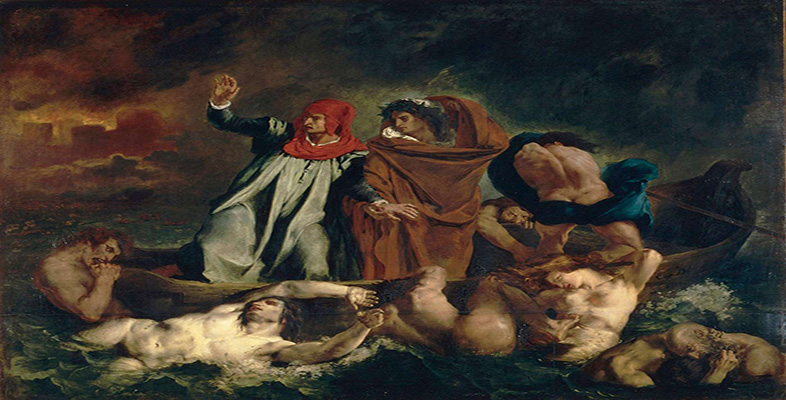3.6 Massacres of Chios – challenging the establishment
If the Barque had marked Delacroix out as an innovator, his next important Salon exhibit, Massacres of Chios (1824) (see Plate 20), was much bolder in its challenge to the establishment. The painting is a fictionalised account of the aftermath of the Turks’ massacre of 20,000 Greeks on the island of Chios, which occurred in 1822 during the Greek Wars of Independence. The massacre was a reprisal for Turkish losses caused by a Greek uprising against Turkish occupation. Again the painting was not commissioned and depicts a subject of Delacroix’s own choosing. It was exhibited at the 1824 Salon, where it won a medal. Although the painting does not conform to the neoclassical norm, there are aspects of its composition which are classical. The figures, for example, are grouped into triangles or pyramids, and there is an overall sense of balance – disrupted slightly on the right-hand side by the Turk rearing up on his horse, literally dominating the Greek victims. Unconventionally, however, in place of the centralised hero or object of interest of a classical composition, there is a gaping hole that allows a view on to distant hills. This lack of a hero, of a visual centre and of a unity of interest (the figures seem singularly uninterested in one another) subverted the normal conventions of history painting. Many critics found the subject too ugly, the figures too cold, passive and defeated, and the technique too rough, disjointed and jarring.
Click to see Plate 20: Eugène Delacroix, Massacres of Chios [Tip: hold Ctrl and click a link to open it in a new tab. (Hide tip)]
For one critic loyal to the Davidian school, Pierre-Athanase Chauvin, this was all too much. He regarded Delacroix’s work as the ultimate Romantic insult to classical beauty:
It is not to arrest the development of our young artists that I am so quick to indicate the steps by which a distinguished painter, the teacher of their teachers [David], led the historical genre to the apogee of its glory; it is rather to establish a necessary point of comparison, which ought to humiliate no one; it is, in short, to avoid the words ‘classic’ and ‘romantic’, or, if you will, to explain them clearly and precisely. The classic is drawn from la belle nature it touches us, it moves us, it satisfies heart and mind together. The more one studies, the more one discovers its beauties; one leaves it with regret, and returns to it with pleasure. The romantic, on the contrary, has something forced, unnatural, which at first glance shocks the eye and upon examination repels it. The artist, in delirium, uselessly combines atrocious scenes, sheds blood, tears out innards, paints despair and agony. Uselessly again, he obtains partial effects in the midst of a thousand extravagances, and makes people who know nothing about it shout, ‘Miracle!’ Posterity will never accept such works, and contemporaries of good faith will grow weary of them; they are weary already. Conclusion: I call Leonidas [a painting by David] … classic, and the Massacres of Chios romantic.
(Quoted in Jobert, 1998, pp.75–6)
